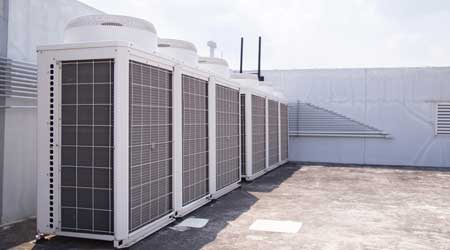
Commercial buildings account for more than 35 percent of the total energy consumption. In most of those structures, heating, ventilation and air conditioning systems consume more than 30 percent of the total energy use.
Building owners and facility managers are challenged with getting financial returns from their investments while providing a building that is energy efficient.
As HVAC systems have become complex, non-linear and dynamic, facility managers are increasingly using building management systems to collect data about the performance of the building, as well as energy consumption by individual equipment such as HVAC systems.
Below, SenseWare offers five ways visibility into such data can help drive maximum HVAC efficiency:
1. Comfort of indoor environment
The importance of an HVAC system in commercial and residential buildings cannot be overemphasized.
The fact remains that fresh air is good for the body, and in commercial buildings, it helps improve productivity. A good ventilation system helps to reduce the number of pollutants, bacteria and odor in a facility.
Data analytics of HVAC systems helps in regulating the temperature of a building and lowering humidity by ensuring that moisture in a building is kept under control. Good ventilation systems remove breeding grounds for dust mites, which contribute to causing eczema.
The American Society of Heating, Refrigeration and Air Conditioning
Engineers (ASHRAE) conducted research that led to Standard 55: Thermal
Environmental Conditions for Human Occupancy. Standard 55 describes how
to assess comfort from specific measurements and predict when most people
will be comfortable.
Data analytics of the HVAC system provides real-time data that helps in maintaining this standard and in preventing any setbacks.

2. Energy efficiency
Operating a HVAC system at optimum efficiency is a challenging endeavor. The number of set points, levels and feedbacks of boilers, chillers, pumps, fans, air delivery components and more can cause costly inefficiencies. Add to that the fact that weather variables affect the heat transfers in a building and increase loads on the HVAC.
Data analytics will provide visibility into your HVAC system with sufficient accuracy that will help you take corrective action and reduce the energy demands and peak load distribution of your HVAC systems.
Facilities Net states that HVAC system maintenance in commercial buildings is responsible for saving more than 40 percent of energy, therefore it is essential to utilize data analytics in understanding the effects of malfunctioning HVAC systems on energy use, energy consumption and energy demand.
3. Improve indoor air quality
According to the Environmental Protection Agency (EPA), poor indoor air quality is among the top factors of environmental risk. Pollutants in the air can aggravate allergies and asthma in some people and cause dizziness and headaches in others.
Air quality depends on various factors like people entering the facility, use of other equipment and presence of electronics. With the proliferation of cheap sensors, air quality data is now being accurately measured.
This visibility into the data can help adjust your HVAC system to improve the air quality. You can develop a maintenance plan that includes:
- Inspection, serving, and cleaning
- Replacement of parts
- Documentation of procedures
- Calibration of components control system
4. Preventive maintenance
HVAC systems often operate at suboptimal levels at least 40 percent of the time in buildings. This is due to the complexity of the buildings, as well as many moving parts like fans, pumps, air-conditioners, ventilators and dampeners.
Data analytics uncovers the following problems of your HVAC system:
- Additional runtime
- Poor control settings and programming errors
- Stuck dampers causing excess outside air intake
- Valve leakage leading to uncontrolled supply-air temperatures
- Outright equipment failure
5. Actionable insights
Data analytics provide essential insights to help with monitoring, controlling and maintaining your HVAC systems. In the absence of this type of information, facility managers physically perform manual audits that are inefficient and time-consuming.
With the advent of IoT, more sensors are being used in buildings for various equipment. The data analytics out of this ocean of data can help determine the best course of action to take to maximize HVAC efficiency.
You can also analyze the information in various ways to better understand the opportunities it presents. For example, you can look at the normalized data for your building type, square footage, schedule and climate.
You can break down the data to better understand energy consumption based on building occupancy and time, thereby identifying peak demand reduction opportunities.
